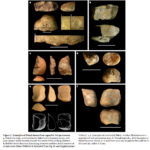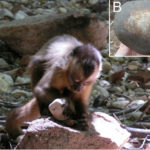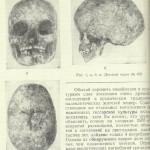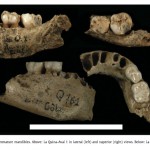
Make Out-of-America Great Again: Humans in the New World at 24,000 YBP
PLoS ONE 12(1): e0169486. doi:10.1371/journal.pone.0169486 Earliest Human Presence in North America Dated to the Last Glacial Maximum: New Radiocarbon Dates from Bluefish Caves, Canada Burgeon, Lauriane, Ariane Burke, and Thomas Higham The timing of the first entry of humans into…

New World Monkeys Produce Hominin-Grade Lithic Tools
Nature 539 (2016): 85-88 doi:10.1038/nature20112 Wild monkeys flake stone tools Proffitt, Tomos, Lydia V. Luncz, Tiago Falótico, Eduardo B. Ottoni, Ignacio de la Torre, and Michael Haslam Our understanding of the emergence of technology shapes how we view the origins of…

Primate Stone Tools: Evidence from South America
One of the contributions of this weblog to our evolutionary thinking is the call for a more holistic, bi-hemispheric approach to hominid and human origins and, consequently, an increased appreciation of New World monkey behaviors as a surprisingly close parallel…

Reader Questions 1: In Search of Archaic Hominin Survivals in Eurasia. Tutkaul Culture
This is a new category of posts on this weblog. Every now and then a reader sends me a question and sometimes I get interested and try to answer. There seems to be a steady interest on the part of…

The Toca da Tira Peia Site and the End of an Ice Age in American Archaeology
Journal of Archaeological Science 40 (2013), 2840-2847 http://dx.doi.org/10.1016/j.jas.2013.02.019 Human Occupation in South America by 20,000 BC: The Toca da Tira Peia Site, Piauí, Brazil Christelle Lahaye, Marion Hernandez, Eric Boëda, Gisele D. Felice, Niède Guidon, Sirlei Hoeltz, Antoine Lourdeau, Marina…
A Seismic Shift in Human Origins Research, or a Downward Slide?
A new research paper is out which has created a lot of media buzz. “Evolutionary History and Adaptation from High-Coverage Whole-Genome Sequences of Diverse African Hunter-Gatherers, “ by Joseph Lachance et al. reports “archaic admixture” in three African hunter-gathering populations…

The Role of Cooperative Breeding in Modern Human Evolution
Journal of Human Evolution 63 (2012): 52-63 http://dx.doi.org/10.1016/j.jhevol.2012.03.009, Allomaternal care, life history and brain size evolution in mammals Isler, Karin, and Carel P. van Schaik. Humans stand out among the apes by having both an extremely large brain and a…
Out-of-Africa in the Mid-Pleistocene: A New Interdisciplinary Paradigm or a New Myth?
In the comments section on this blog, Dienekes raises the issue of interdisciplinary support for the out-of-America theory. Since I’m a big proponent of interdisciplinarity, the seeming convergence of genetics, archeology and paleobiology on the origin of modern humans in…

Early Aurignacian Dentition and Why Paleontology Is a Moving Target
Journal of Human Evolution (In Press, Corrected Proof) The Early Aurignacian human remains from La Quina-Aval (France) Christine Verna, Véronique Dujardin, and Erik Trinkaus. There is a dearth of diagnostic human remains securely associated with the Early Aurignacian of western…


Recent Comments